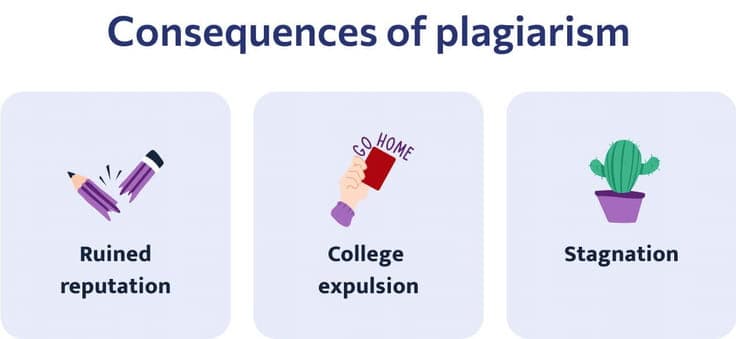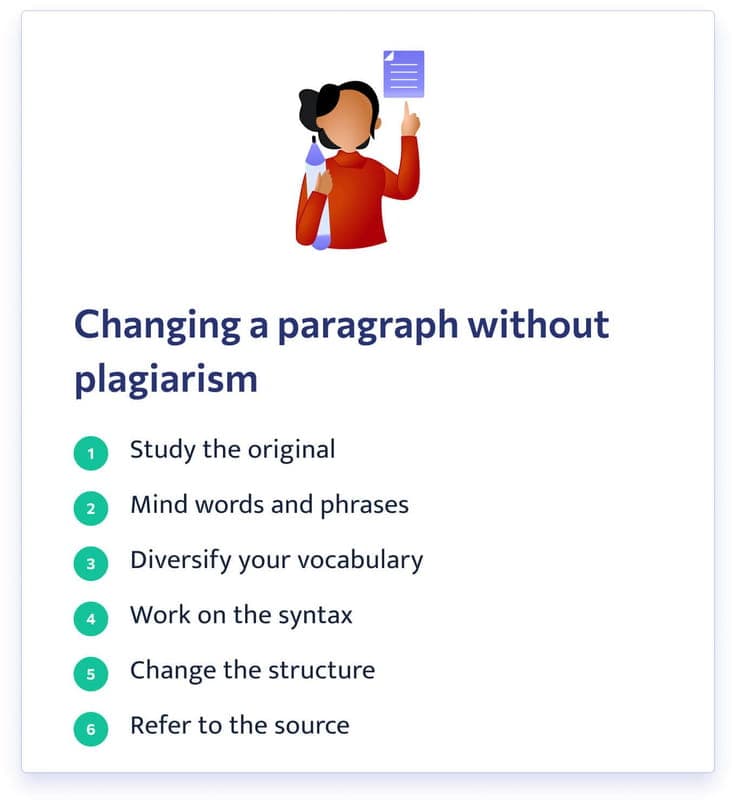Students regularly work with large texts. They need to study various readings, like books and articles, and then present their findings in their own words. This aspect of academic work usually requires you to change paragraph structure and content by presenting it as your own product.
🛠️ How Does This Paragraph Changer Work?
That’s how our simple and user-friendly online paraphrasing tool works. You only need to take a couple of simple steps:
- Insert your original text
- Choose the degree of rewrite (from 20% to 100%)
- Click “Change”
❌ Why Must One Avoid Plagiarism in Academic Writing?
When you deal with large academic loads, the temptation may be too high to present others’ words as your own ideas. It’s a time-saving approach, especially if you fully agree with the author and like their style.

However, it’s the worst mistake some students and even experienced researchers, authors, and journalists commit.
Resorting to plagiarism is always a self-defeating strategy because it comes with a risk of:
- Ruined reputation. If you plagiarize and get caught, you may lose a solid position in the academic world (especially if you’re already a renounced author or researcher).
- College suspension or expulsion. Students whose works are flagged for plagiarism may be expelled from educational establishments, losing their tuition money and ruining their careers.
- Stagnation. Those who choose to plagiarize instead of working on paraphrasing skills end up with mediocre writing proficiency.
🔀 How to Change a Paragraph without Plagiarizing?
So, how to rewrite any material you collect for your essay and turn it into own words without sounding like a copycat?

Here are the top 6 tips from experts that will help you change paragraph into different words and avoid a plag scan alert:
📝 How to Change a Paragraph: Good & Bad Examples
Let’s illustrate everything we’ve just discussed on the example of paraphrasing done well and poorly. We’ll use a fragment from Nancy Coller’s article “Why It’s So Empowering, and Hard, to Say What’s True” recently published in Psychology Today.
The original text reads like this:
“Often, we start telling the truth simply because we can’t continue not telling it. Being what everyone wants and needs us to be, and getting everyone to like us, becomes so darn exhausting and depleting that we can’t and don’t want to keep doing it. It stops meaning so much that the flight attendant or barista likes us; we just can’t use that approval to fuel us in the same way. We simply don’t have the energy for it. At the same time, we start telling the truth because living off the fumes of being well-perceived and liked at the expense of being real becomes unsustainable. And the split we live with—making other people okay when we’re not being honest, becomes unbearable.”
A Bad Example
Sometimes people tell the truth as they can’t continue telling lies. Meeting everyone’s expectations and seeking love from everyone can be tiring, making people stop wanting to do that. People stop thinking that a flight attendant’s or barista’s sympathy is important; that approval stops being their fuel. Many people lack the energy to continue. Simultaneously, they start being honest because a positive perception costs too much. The divide that people feel in making others feel convenient at the expense of their honesty takes a toll on them.
This example of paraphrasing doesn’t look good because:
- It follows the exact syntactic structure of the original text and only changes some words.
- Many notional words are simply changed to their synonyms, thus preserving a close analog of the original text; this form of a loose rewrite is referred to as ‘mosaic plagiarism’.
- This text never mentions the author of this text, which means appropriating one’s ideas and claiming them to be yours.
A Good Example
As Nancy Coller claimed in her article about truth-telling, the truth comes as a natural outcome of the inability to live another way. Some of us get trapped in the vicious cycle of meeting others’ expectations and being likable, wasting so much energy on those meaningless activities and ending up exhausted. At that point, being liked by strangers, like a waiter or a passer-by, doesn’t result in the fulfillment we used to feel, and the illusion of energy is lost. Besides, the habit of being true appears when a person weighs the costs of truth versus a good reputation and understands that the former comes at a lower cost. Thus, people need to address the divide between social likeability and honesty to resolve an inner crisis they can no longer tolerate.
This example looks much better:
- It preserves the content but has a different structure and uses varied syntactic forms to deliver the same message.
- The fragment starts with a reference to the original source, which secures the writer’s position and clarifies that the idea was borrowed and rephrased rather than created on their own.
- This text has a much lower chance of being flagged for plagiarism.
Thank you for reading this article! We hope that the above information was useful. Check the other writing tools we’ve prepared: essay shortener and heading generator.
Updated: